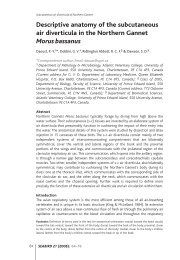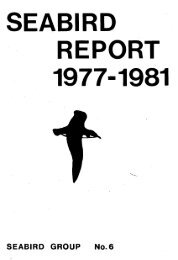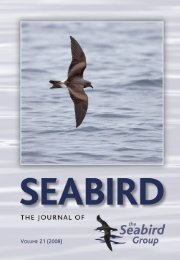Create successful ePaper yourself
Turn your PDF publications into a flip-book with our unique Google optimized e-Paper software.
152 B. CADIOU Atlantic <strong>Seabird</strong>s 3(4)<br />
census of the colonies was made after the peak of egg laying, mainly from July<br />
to September. All visits were conducted by day. Combinations of different<br />
methods were used for census: direct observation with a torch, direct<br />
investigation by hand and tape-playback method. Direct investigation by hand<br />
was made very carefully to limit disturbance and to avoid nest desertion,<br />
without taking out the adults, and by slipping the two longer fingers delicately<br />
under the bird to search for an egg or a chick. In most cases when using this<br />
technique, adults did not move away. For the playback method, a male purr call<br />
recorded on Banneg Island in 1989 by V. Bretagnolle was played for about 20 s,<br />
once or twice, using a standard tape recorder (Tamashi C-671). Occupied and<br />
attended nest sites refer, respectively, to sites with at least one proof of<br />
occupancy over the whole breeding season and to sites with at least one adult<br />
present at a given visit.<br />
Laying phenology At the different colonies, all accessible chicks were ringed<br />
(except in 1996), and their age was estimated to the nearest five days using data<br />
on plumage development (Davis 1957). Other visible chicks were also aged in<br />
the same way. Estimation of the laying date was made by back-calculation,<br />
considering the chick’s age and an average incubation period of 41 days (Davis<br />
1957; Scott 1970). All sites with incubating birds or unhatched eggs on one day<br />
were as far as possible checked once again later in the season until hatching or<br />
failure was recorded.<br />
<strong>The</strong>re are at least three potential biases that can affect the estimate of<br />
the laying date from chick ageing. In the first place, the incubation duration is<br />
variable, ranging from 38 to 50 days, with a mean value of 41 days (Davis 1957;<br />
Scott 1970), used to back-calculate the laying date. Secondly, late laid eggs have<br />
lower hatching success (Scott 1970), and therefore all of them can not be taken<br />
into account. Thus, laying periods obtained from chick age are always partially<br />
truncated and slightly underestimated (see also Ratcliffe et al. 1998a). Thirdly,<br />
laying date may be overestimated for retarded chicks. But such chicks are<br />
generally easy to identify as they are lighter and smaller, sometimes unhealthy,<br />
and can be excluded from the analyses. <strong>The</strong> older the chick, the greater the<br />
effect of retarded or accelerated growth on the estimation of laying date. As<br />
discussed by Scott (1970), accuracy of ageing on plumage development can be<br />
very low in poor seasons, but in the present study, chick growth, based on<br />
weight and wing length at ringing, was very similar in 1997, 1998 and 1999 (B.<br />
Cadiou unpubl. data).<br />
In 1999, 51 chicks were aged at least twice in the season within<br />
approximately 4 weeks, of which three were also aged a third time. <strong>The</strong><br />
difference (mean ± SE) in the estimate of the laying date between the second<br />
and the first observation, or between the third and the second one, was -1.1 ± 0.6








